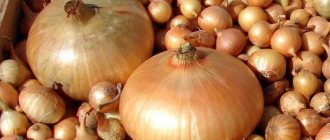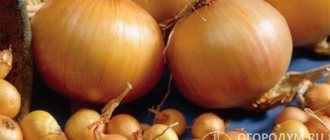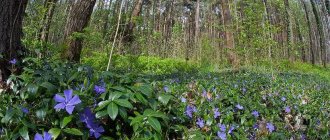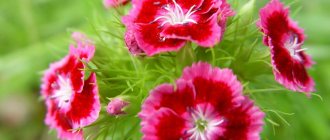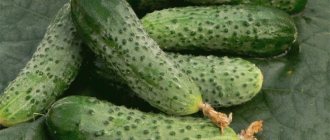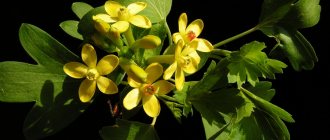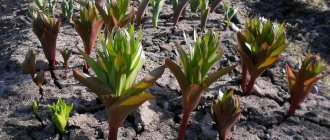The onion variety Stuttgarter Riesen was bred in Germany, and in Russia it was officially included in the register of agricultural products in the same 1995.
Dear readers!
For you, we have created communities on social networks in which useful articles and interesting ideas are published several times a day! Subscribe and receive useful content in a convenient format! It is considered a universal variety, suitable for growing both feathers and bulbs. Suitable for cultivation throughout the center of Russia, the Volga region and the central, southern parts of the East Siberian region.
The average yield is considered quite high and, with industrial cultivation, varies between 101-351 c/ha. The variety was specially bred for cultivation in temperate climates, as it has excellent resistance to frost and is famous for its strong immunity.
Description of the variety Stuttgarter Riesen
Well adapted to the climate of the areas where it is grown, having above-average yields and easily resisting many diseases and pests - this is all about the Stuttgarter Riesen onion variety. It is well suited for cultivation in Russia throughout the temperate zone. Moreover, in most situations it will have time to ripen and produce a high-quality, well-stored harvest, even if spring arrives late and in a relatively cold summer.
Appearance of the bulb
The Stuttgarter Riesen variety looks extremely classic for onions: it has yellow, golden or rich brown scales. The most important distinguishing feature of the variety is the bulb, which is slightly flattened at the top and bottom and is not perfectly round.
Their weight can vary from 70 to 200 grams, but in general it can be noted that they are either medium or very large in size.
Ripening time and ripening
Moderate temperatures and long, dry summers are ideal conditions for the ripening of the Stuttgarter Riesen variety. However, in some northern territories it is possible to grow the crop quite calmly, obtaining good harvests year after year.
In the south, the first harvests are expected from the end of May. In the middle zone - in June-July. And in regions with short summers, onions will almost always have time to ripen before the first frost in late summer or early autumn. The variety will survive low temperatures and even frosts, as it is early.
Purpose of the variety
The variety is best suited for growing as bulbs. But it is known that greens from it also have a classic aroma and taste. True, it grows a little more sparingly than on some other onion varieties, which sprout leaves more readily.
Productivity
The collection of bulbs is highly dependent on weather conditions. The drier the spring and the first part of summer, the more sunny days, the better and faster the bulbs of the Stuttgarter Riesen variety ripen and its green mass grows.
However, even under unfavorable conditions, the total yield per 1 m2 rarely falls below 3-4 kg of bulbs. And under optimal conditions and, which is quite important, good fertilizing (it is enough to do it at least 2 times in the spring), you can increase the crop yield by 40-60%.
Transportability
Stuttgarter Riesen tolerates transportation well and practically does not lose its presentation. In many ways, all this is due to its rather peculiar feature - the solid structure of its protective scales.
BY THE WAY. This is even one of the often noted disadvantages of the variety, because its bulbs are more difficult to peel.
Keeping quality
Many people note that Stuttgarter Riesen is stored very well and for a long time. It is only important that before storing for a long period of storage, do not forget to sort and put the best bulbs separately from those that look suspiciously soft or uneven in color.
The bulbs are supposed to be stored in a completely standard way: hanging from the ceiling or putting them in dry, well-ventilated bags, nets, or stockings. The main thing is that the room where onions of this variety are stored is not humid, with a constant low temperature and a minimum of natural light.
Taste
The taste of Stuttgarter Riesen onions is classic. It is dominated by slightly spicy notes, with noticeable sourness (the variety is very rich in vitamin C) and a noticeable pungency. The aroma is distinct and traditional.
Disease resistance
Many early varieties of garden crops have excellent immunity. This case is no exception.
This onion variety is really rarely affected by diseases and is not particularly liked by pests. Throughout the entire growing period, 1-2 pest control treatments are usually sufficient, and even then they are often purely preventive in nature.
Advantages of the Stuttgarter Riesen variety
The Stuttgarter Riesen onion variety was first bred in Germany, and only then spread throughout the world. Today it is one of the most popular onion varieties in the temperate zone of the globe. It is grown in Europe, Asia and America.
ON A NOTE. The Stuttgarter variety is considered one of the richest among garden onions in terms of vitamin C content in the bulbs and feathers.
This onion is valued for many positive properties:
- Very low maintenance.
- Good adaptability to the climate of the growing region.
- Early maturation.
- Lasting immunity.
- High yield - on average it ranges from 4-8 kg per square meter of plot.
- Versatility: the variety is grown for both greens and bulbs.
- The bulbs and feathers have a classic taste and aroma.
- The bulbs fit well.
Main characteristics
First, we highlight the most significant characteristics of the variety and present them in the table:
| Parameter | Characteristic |
| Culture | Onion (Allium cepa L.) |
| Variety | "Stuttgarter Riesen" (Stuttgarter, "Stuttgarter Riesen") |
| Ripening time | Early ripening: reaches technical ripeness 68-85 days after emergence |
| Plant type | Spicy |
| Purpose | Universal |
| Growing conditions | Commodity production, gardening |
| Productivity | High: about 4-7 kg/m2 (maximum up to 14.4 kg/m2); in industrial plantings – up to 102.8 t/ha |
| Bulb weight | On average 25 g (up to 50-94 g) |
| Form | Flat-round |
| Scale color | External (dry) yellow, golden brown; internal (juicy) – white |
| Taste qualities | Spicy, juicy |
| Storage duration | 4-6 months |
| Year of entry into the State Register of the Russian Federation | 1995 |
| Recommended growing regions | Central (3), Volga-Vyatka (4), Middle Volga (7) and East Siberian (11) |
| Originators | Satimex Quedlinburg GMBH (Germany); Avista LLC (Moscow); JSC "Ozery" (Moscow region, Ozery); N. M. Nasrullaev |
| Year of entry into the register of Belarus | 1991 |
| Originator | OJSC "MinskSortSemOvoshch" (Minsk region, Gatovo village) |
50 days after germination, the feather reaches a height of 45-47 cm with 8 leaves
Disadvantages of the Stuttgarter Riesen variety
It is almost impossible to identify serious shortcomings in this bow. But there are only minor negative points noted in reviews of the variety:
- The bulbs are quite difficult to peel.
- It is believed that Stuttgarter Riesen is not well suited for growing for greens, as it produces fewer feathers compared to many other onion varieties.
- It is assumed that onions are suitable for growing in temperate climates and are not afraid of cold weather, and this is true. But, nevertheless, the culture grows better the warmer the climate.
- When humidity is high, prepare for a significant drop in yield. Mainly due to rotting bulbs. For example, this happens in rainy summers.
Advantages and disadvantages
The popularity of the German variety is explained by the presence of a number of advantages:
- early or mid-early turnip harvest time (it has time to ripen in all regions);
- high yields (from 3 to 5 kg per square meter);
- unpretentiousness in agricultural technology;
- excellent keeping quality, shelf life until spring;
- universal use;
- suitability for growing in spring for greenery at home;
- excellent taste;
- resistance to shooting.
The variety has beautiful bulbs, which makes it popular for growing for sale.
The disadvantages include the following:
- not very convenient shape of the turnip (flattened, with a notch at the neck);
- susceptibility to downy mildew and neck rot (manifests itself when the soil is waterlogged in the rainy season);
- unsuitability of onions for winter planting (only small-fraction sowing, which will dry out during storage).
The “pros” outweigh, especially since in a favorable season the variety produces excellent yields with minimal care.
Onion cultivation Stuttgarter Riesen
Due to the fact that the Stutrter Riesen variety is early, it can easily be grown to full maturity both from seeds (including planting them directly in open ground) and from onion sets. Moreover, this condition is typical not only for the middle zone, where most gardeners work in our country, but also for Siberia, the Urals, regions north of Moscow, the north-west of the country, and the Baltic states.
True, based on many opinions and reviews, it is recommended to grow sevcom crops in not the warmest and most stable climates, since this is a much simpler and more reliable way.
Growing from seeds
If you still give preference to seed cultivation, then two types of actions are permissible for this variety:
- Immediately sow outside.
- First, growing the seedlings, and then transplanting them to a permanent place.
In the first case, planting is done quite early, when the ground warms up to +5-7°C and the air to +10-15°C. This time usually falls in early or mid-April in most regions.
BY THE WAY . Seeds can also be planted before winter. But then, so that they do not have time to germinate, they do this already with the onset of the first frost.
Before planting, the seeds are soaked in a weak solution of potassium permanganate. Planted in ridges with a distance of 15-20 cm between them. Place 3-5 seeds together, then make 10 cm gaps.
After germination, the bulbs can be thinned out, or you can leave everything as is. There is no consensus on this matter.
Growing from seeds through seedlings
If spring usually comes late in the region and winters are cold, then it is more difficult to grow high-quality bulbs using the usual seed method. Then they resort to germinating seedlings.
The planting material is also soaked and disinfected, and then planted in specially prepared containers with a nutrient solution. They begin working with seedlings in mid-to-late February. And since at this time there is still not enough natural light, artificial supplementary lighting will have to be organized sometime before mid-March.
In mid-April or at most early May, the seedlings are transferred to a permanent growing place outside.
How to grow from onion sets
The main reason why they choose to grow the Stuttgarter Riesen variety is the early ripening period.
REFERENCE. Onion sets of this variety can be harvested 60-70 days after planting in open ground. And if you grow the crop with seeds, it will take at least 100-120 days.
It is important to choose good planting material. As you can see in many recommendations, experienced gardeners say that you need to select bulbs of a uniform color and always without visible damage.
Immediately before planting outdoors, it is advisable to warm the onion set well by placing it next to a radiator or stove for 8-12 hours.
The bulbs do not need to be soaked before planting, but spraying their surface with a weak solution of potassium permanganate will not hurt.
As is usually typical for onions, you need to sort the bulbs into large, medium, and small. They should be planted in separate beds: large with large, small with small, etc. You can plant it either before winter (then it is advisable to do this 3-4 weeks before frost, which is October-November), or in early spring in well-warmed soil (late April - May).
25-30 cm should be left between the furrows, and at least 10 cm between the bulbs themselves.
When to plant: in spring or autumn?
This variety can be fed with sets or seeds. The second option is characterized by the fact that planting material reacts sharply to temperature changes and can lag behind in development.
Onion seeds Stuttgarter
Planting is done both in autumn and spring . When sowing in autumn, you should use smallish sets, because during storage they dry out very much. Autumn plantings need to be mulched using humus or peat. The vegetable does not make any special demands on the composition of the soil, but gives preference to fertilized beds in which the acidity level is neutral. In these places the yield will be especially good. The seeds can be harvested after 100–20 days. Sevok will give you the opportunity to start harvesting just over two months after planting.
The best predecessors are cucumbers and tomatoes, and legume varieties. Onions should not be planted after potatoes . He will grow up lethargic and exhausted, and in a serious winter he may simply freeze to death.
Caring for Stuttgarter Riesen outdoors
Although it is known that this variety is very unpretentious, it is definitely worth knowing and following some secrets of proper care for it. This way you can grow a much better and tastier harvest.
Watering
First of all, choose well-lit areas in your garden. Secondly, take care of proper watering. For the Stuttgarter Riesen variety, 1-2 waterings per week in summer and 1 in spring are sufficient.
And be sure to ensure that there is no stagnation of moisture in the area.
ON A NOTE . 3 weeks before harvesting, watering should be stopped completely.
Weeding and loosening
Loose, well-permeable soil is the basis for the best onion harvest. The first weeding can be as early as 1-2 weeks after planting, when the bulbs can be clearly distinguished. In the future, loosening and weeding should be done regularly.
Fertilizer and feeding
You can remember the idea that the Stuttgarter Riesen onion will grow by itself. But if you feed it at least once in the spring, the harvest will be larger, it will lie better in the cellar and will simply turn out to be tastier and more aromatic.
When choosing fertilizers, it is better to give preference to superphosphates. But you can’t use fertilizers too often. The maximum for onions of this variety is 3 feedings for the entire warm season.
Growing a variety in a greenhouse
If you grow Stuttgarter Riesen in greenhouses, it ripens much faster. The plant's love for warmth is reflected. The only possible risk of crop destruction is associated with high humidity. No variety of onion will welcome this quality.
Early varieties of greenhouse onions can be planted with seeds and sets. The best time for this is very early spring, early and mid-March. The crop will be fully ripe at the end of spring.
Preparation of planting material for feathers in winter
For planting, only onion sets are used. Seeds for this type of planting are considered unsuitable. Read about the features of planting onion sets in the fall here.
Work with small onions like this:
- To begin with, the planting material is carefully sorted. Only bulbs of the correct shape are left, without any significant visual defects. Do not use rotten, moldy or broken samples for planting.
- Next, the sets are heated to a temperature of 42 degrees. This process takes experienced vegetable growers 8 hours. You can use central heating or stoves for it (if you live in a private house). In this case, you need to carefully ensure that the seed does not dry out or overheat, otherwise it may not sprout.
- On the eve of transplanting to the ground, the onions must be soaked. To do this, take a bucket of warm water with a temperature of 35 to 40 degrees Celsius, add potassium permanganate to it in a proportion of 0.1 grams per liter of liquid. After this, a few drops of aloe juice are also added to the solution. If you don't have it on hand, you can do without this ingredient. The bulbs are soaked in the resulting solution for knocking.
- After 24 hours, the seedlings are taken out of the water and laid out on burlap or film. After this, they wait until the seed dries out a little, and only after that they begin to sow it.
- The bulbs themselves are planted in rows in the garden. At the same time, they maintain a space between such rows of 25 centimeters. The bulbs themselves are placed at a distance of at least 10 cm from each other (otherwise they will interfere with each other’s development). After sowing, the beds are watered with a small amount of water.
Onions are planted in rows, while maintaining a spacing of 25 centimeters.
Particular attention is also paid to the choice of time for planting onions. So, very small sets are planted early in the morning, but larger specimens are planted closer to lunch, as soon as the soil warms up to at least a temperature of 10 degrees.
Diseases and pests
Diseases and pests are rarely encountered when growing such an unpretentious variety.
There are only a few manifestations to be wary of:
- The most dangerous disease is root rot. Occurs due to high soil moisture and swampy areas.
- The variety is also considered highly susceptible to downy mildew.
- The most common pest on Stuttgarter Riesen is the onion fly.
Pests are usually controlled with standard insecticides and fungicides, using them strictly according to the manufacturer's instructions. But most likely, it will not be possible to get rid of diseases. Affected plants will have to be removed from the beds.
Care
Stuttgarter onion sets do not require special care after planting, but some measures must be taken. After a couple of weeks, the first feeding is carried out with a solution of mullein or chicken manure in a ratio of no less than 1:10. Otherwise, there is a risk of burning the heads. Under no circumstances should fresh manure be used for fertilizing. This leads to cracking of the heads and the appearance of pests. During the growth period of Stuttgarter bulbs, plants need phosphorus and potassium. Therefore, after a month, the plantings are watered with potassium salt, urea or superphosphate. The third feeding is carried out using complex mineral fertilizer.
Onion sets - the best varieties for Siberia
The lack of certain microelements can be determined by the external condition of the Stuttgarter onion. Slow growth of green mass indicates nitrogen deficiency. Wrinkled and prematurely aging foliage indicates a lack of potassium. Blackened feather tips indicate a lack of phosphorus.
In the absence of such signs, experienced gardeners advise avoiding fertilizing. According to them, it is better to underfeed the Stuttgarter than to overfeed it.
During the entire growing season, it is necessary to keep the beds clean and remove weeds in a timely manner. To ensure good air access to the roots, the soil is carefully loosened. In this case, the developing bulbs must not be damaged, otherwise they will become infected. Watering is carried out taking into account weather conditions. If it is hot, then irrigation for Stuttgarter is required more often, but after this it is necessary to loosen the beds. In early July, watering should be less intense, and a couple of weeks before the expected harvest, it should be stopped altogether.
Despite the fact that Stuttgarter is resistant to diseases and pests, experts recommend planting several dill and marigold bushes in its bed to repel insect pests.
Harvest and storage
Without any obvious connection to the northern or southern climate, the Stuttgater Riesen onion ripens at approximately the same time. If you plant it not before winter, but in early spring, then with the seed growing method it will take at least 3.5 months to grow to normal size, and when germinating bulbs - 2.5-3 months. This is quite fast, so onions can be easily cultivated even in a rather harsh climate and with a relatively short summer.
Usually, yellowing feathers indicate that it is time to harvest onions.
Before storing the bulbs for long-term storage, it is recommended to carry out standard “onion” procedures: shorten the roots as much as possible, cut off the feathers and sort the crop. Rotten and soft onions cannot be stored for a long time, so they are either thrown away or set aside for consumption first.
The collected bulbs should be allowed to dry. To do this, they are left on the beds and dried after harvesting for 1-2 hours.
There are several ways to store this variety:
- in fabric bags in bulk;
- hanging in nets/stockings;
- hanging with braids from the ceiling.
It is advisable that the storage space be dry and dark: for example, a cellar or semi-basement is perfect.
The harvested crop lies quite well and can be stored without problems until the next harvest in the spring.
What difficulties may arise during cultivation?
If you do not take into account that the Stuttgrater Riesen variety is, not without reason, considered very undemanding, certain difficulties are encountered even with caring for it.
So, it is not recommended to plant the crop on acidic soils - the bulbs will hurt, and the harvest will be far from ideal. If the soil is highly acidified, extinguish it with lime and ash in early spring.
The ideal option for onion growth would be sunny places, necessarily located away from lowlands and wetlands. Any onion, and this variety is no exception, is prone to rotting. Therefore, it is important for the crop to choose loose soil that is well permeable to air and moisture.
Choosing a landing site
Stuttgarter Risen thrives best on acidic dry clay soils of neutral type. For growing as a business, loose, light, fertile soil is ideal. Do not plant it on acidic soils - this may negatively affect the yield of the crop. When planting onions for the winter, be sure to first add peat and humus to the soil in order to increase the fertility of the site.
This culture must be placed in a well-ventilated, bright place where water never stagnate. Otherwise, the seedlings may rot at the end of autumn, and you will lose the entire harvest. How to plant onion sets correctly is described in this article.
Reviews from gardeners
Irina Topunova: I have been using the Stuttgarter variety for a long time and have never regretted it. I heard a lot that he is very unpretentious. And I agree with this. The only thing I especially advise is not to disdain feeding. I make them 2 times a year. It doesn’t seem like much, but the harvest is getting significantly larger.
Irina Krivosheyko : I can’t say that I experimented a lot with onion varieties. It would be more correct to say that Stuttgrater Riesen began to plant almost immediately. What suits me is the real possibility of planting and forgetting. You don't have to feed it, just water it. And even then, the onion will easily survive care in the format when necessary. For example, I manage to raise him at the dacha, where we only come on weekends. The onion itself has a regular, classic taste. Easily grown for both bulbs and feathers.
Antonina Skripenko : I like that it is possible to grow this onion in the Vologda region for both the bulb and the feather. The taste is excellent, rich, adds flavor to dishes. Even here in the north, the yield is encouraging. You can collect a good box like this from a couple of three beds.
Answers to frequently asked questions
How to grow a variety - on a feather or on a bulb?
Both ways are acceptable. Optional.
What kind of bulbs should I put on the feather?
Those that are of worse quality. It is even recommended to plant them in a special way: densely next to each other. And for bulbs, create a larger distance between them when planting.
When is the time to harvest the bulbs?
When the feathers turn yellow, they begin to fall off and bend towards the ground.
How long does the variety grow?
Usually from 60 to 120 days depending on the planting method.
When is it better to sow - in spring or autumn, is it possible before winter?
This type of crop belongs to winter crops. Therefore, it is planted in late autumn or early spring. Experienced gardeners involved in crops change the area for planting winter onions every season.
Regardless of when and in what way onions are planted, the land must be prepared - dug up and saturated with the necessary fertilizers. Although you can get a good harvest on depleted land. Naturally, the onion will be small, but it will retain its taste properties.
When planting in the fall, you should adhere to the rule - have time to plant before the onset of frost. The seed material must nest and adapt for the winter.
Spring planting begins in mid-April. But the landing time is individual for each region. The basic rule is the soil is heated to a temperature of at least ten degrees.
Onion heads planted in the fall are larger, have increased immunity and last longer.
Important. To increase productivity, crop rotation must be observed.
The beds are ideal after:
- cabbage;
- beans;
- peas;
- beans;
- cucumbers;
- tomatoes.
After greens and carrots, the harvest will be poor.
